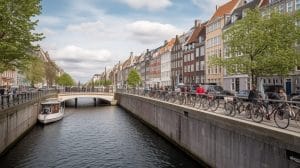Introduction to Bike-Friendly Cities: Cycling Paradise Unveiled
Bike-friendly cities are progressively transforming urban landscapes across the globe, reshaping the future of sustainable transportation. Cycling has been deeply embraced as much more than just a leisurely activity, becoming an essential mode of transportation that harmoniously merges natural beauty with city bustle. Cities like Copenhagen and Amsterdam, nestled in the heart of Europe, notoriously stand out for their extensive network of bike lanes, vibrant cycling culture, and commitment to promoting cycling as a viable city transit solution. In these charming streets, cycling culture is deeply imbued in daily life, while the city’s unique cycling experiences mesmerize cyclists of all levels amidst picturesque landscapes, iconic landmarks, and a rich history.
In a bike-friendly city, a cyclist is greeted with a wealth of amenities; from extensive and well-maintained bike paths that spiral throughout the city center to dedicated bike lanes ensuring a safe journey. Moreover, such cities often boast comprehensive and expanding networks of bike lanes, making it easy for anyone on two wheels to explore the city’s vibrant charm and breathtaking landmarks. Other commendable features often include:
- A vibrant city center teeming with bike-friendly cafes that allow for a leisurely escapade amidst daily trysts.
- The commitment to sustainable transportation is evident in the substantial investment in bike-friendly infrastructure, including bike parking facilities, protected bike lanes, and bike rentals.
- The city’s commitment to cycling is reflected in its passionate cycling community, which often serves as a testament to the city’s bicycle culture.
- An accessible and enjoyable cycling experience provided by scenic routes and dedicated bike paths offering an unparalleled perspective of the city’s sights and sounds.
This interspersing of urban ethos with cycling culture in these cities showcases a sustainable model for other cities around the world to emulate. This commitment to urban cycling, paired with efforts to make cycling accessible for everyone, truly unveils a cycling paradise amid our concrete jungles.
Copenhagen: A Sustainable Cyclist’s Haven
 Copenhagen, often lauded as one of the world’s best cities for bicyclists, is the quintessential destination for cyclists. The city’s commitment to cycling excellence is evident in its vast network of bike lanes and bicycle-friendly infrastructure. Copenhagen has wholly embraced cycling as a sustainable mode of transportation, which allows visitors and locals to thoroughly explore the city on two wheels.
Copenhagen, often lauded as one of the world’s best cities for bicyclists, is the quintessential destination for cyclists. The city’s commitment to cycling excellence is evident in its vast network of bike lanes and bicycle-friendly infrastructure. Copenhagen has wholly embraced cycling as a sustainable mode of transportation, which allows visitors and locals to thoroughly explore the city on two wheels.
Reflecting its rich history and forward-thinking environmental strategies, the city boasts an impressive cycling infrastructure unparalleled by other cities in the United States and Europe.
The bike-friendly streets are teeming with enthusiasts; it’s estimated that more than half the city’s residents cycle daily, making Copenhagen a true cycling paradise. Copenhagen’s strong passion for cycling comes to life in its wide-ranging measures facilitating the joy of cycling. The city has made significant strides in creating an efficient and safe environment for its citizens and visitors, which includes, among other things, robust bike parking solutions and bike-friendly city planning.
From the hustle and bustle of its busy streets to more peaceful routes, one can rent a bike and set off to explore the city’s iconic landmarks with great ease. Thanks to its well-planned cycle paths, Copenhagen allows everyone, from professionals to novice cyclists, to enjoy the ride amidst its historic charm. With its multifaceted cycling culture and infrastructure, Copenhagen stands proudly among the top cities in the world where cycling is much more than just a means of transportation—it’s a cherished local tradition.
Recommended from Medium: Best Features of Amsterdam’s Biking Systems
Amsterdam is universally acknowledged as one of the most bike-friendly cities globally, serving as a thrilling paradise for cyclists and bike enthusiasts alike. The city’s biking system offers a unique experience, with bicycle enthusiasts from across the world flocking here to witness the capital city’s cycling city culture. The robust cycling infrastructure of Amsterdam is not just a mere means of transportation but an integral part of the Netherlands’ lifestyle. Interestingly, the bike-friendly atmosphere is felt throughout the city right from the streets of Amsterdam to the abundance of bicycle parking facilities. Whether you’re a local or a tourist, riding a bike is an essential part of experiencing the cultural flavor of Amsterdam.
Equally important is its commitment to Amsterdam towards promoting cycling as a way of living, making it an ideal destination for bike lovers. Let’s discover the top 10 features that make Amsterdam’s biking system eminent:
- Comprehensive Cycle Paths: Extensive and well-maintained bike lanes keep cyclists safe from traffic congestion.
- Bicycle Parking: Numerous dedicated bicycle parking spots dot the city.
- Bike-Sharing Programs: Affordable and accessible, these programs encourage more people to cycle.
- Bike Repair Shops: Easily found throughout the city to ensure uninterrupted biking adventures.
- Rules Favor Bikers: The city’s traffic laws are designed to prioritize cyclists’ safety.
- Bike Café Culture: Many cafes cater to cyclists, further promoting a bike-friendly atmosphere.
- Cycle Tours: Ample bicycle tour options allow tourists to explore the city on two wheels.
- Family-Friendly Biking: Special bikes and accessories make it easy for families to bike together.
- Bike-Friendly Public Transport: Cyclists can bring their bikes on trams or ferries to more distant destinations.
- Bike Education: The city offers cycling training and safety courses.
This commendable commitment to cycling and impressive infrastructure truly makes Amsterdam stand out from other cities and cements its position as one of the best cities in the world for cycling enthusiasts.
Understanding the Importance of Sustainable Transportation
Understanding the importance of sustainable transportation is intrinsic in tackling emerging global challenges such as pollution, congestion, and climate change.
 As urban growth continues to increase, the use of cars as a primary means of transportation becomes increasingly inefficient and detrimental to our environment. Incorporating sustainable transportation networks into urban planning and infrastructure, like those observed in bike-friendly cities, can significantly reduce our carbon footprint, improving air quality and public health.
As urban growth continues to increase, the use of cars as a primary means of transportation becomes increasingly inefficient and detrimental to our environment. Incorporating sustainable transportation networks into urban planning and infrastructure, like those observed in bike-friendly cities, can significantly reduce our carbon footprint, improving air quality and public health.
Sustainable transportation isn’t just about reducing emissions, it’s about creating cities that are livelier, healthier, and more conducive to human interaction and activity.
Let’s venture down the streets of Copenhagen, a city renowned for its sustainable transportation initiatives. To comprehend the city’s progress, it’s crucial to identify the integral steps cities stand to take to achieve this goal. Firstly, encouraging public transportation over private is paramount, offering bus, tram, and metro options that are both frequent and reliable. Next, implementing bike lanes and walking paths to enable safe, convenient, and active means of transport. Finally, incorporating seamlessly integrated ride-sharing and electric vehicle initiatives can also contribute towards sustainable mobility. These examples promote not only environmental stewardiness but also social cohesion by prioritizing communal spaces and human mobility over vehicles. Various cities should take a leaf out of Copenhagen’s book and view sustainable transportation not as a hassle, but as an opportunity for long-term societal and environmental betterment.
Final Thoughts: Cycle Your Way to a Sustainable Future in Bike-Friendly Cities
In a bid to address environmental issues and promote healthy lifestyles, many urban areas around the globe are transitioning into bike-friendly cities. These cities are building infrastructures to encourage cycling as a preferred mode of transportation, by building extensive bike paths, implementing cycling safety measures, and creating favorable cycling policies and programs, among others. The adoption of cycling not only plays a significant role in reducing atmospheric pollution and traffic congestion, but it also offers immense health benefits. With increased cardiovascular fitness, muscle strength, joint mobility, and reduced levels of stress, cycling is arguably a step in the right direction toward a sustainable future.
However, to achieve the full potential of cycling as a viable mode of transportation, each bike-friendly city must tailor its strategies according to its unique challenges and needs. It is essential to develop a well-detailed and organized urban cycling network, incorporating bicycle lanes and parking facilities, as well as regular bike servicing stations across the city. Other potential strategies include implementing more stringent laws to protect cyclists on the road, promoting cycling campaigns and education, and developing bike-sharing programs. Undoubtedly, the path to a sustainable future requires collective effort and commitment.
Biking in eco-friendly cities presents an expedition of discovery, learning, and change – an experience worthwhile for both the environment and the individual. By embracing cycling, cities not only pave the way toward sustainability but also foster communities that prioritize health, well-being, and environmental consciousness. As more people cycle their way through cities, we collectively contribute to a greener, cleaner, and more sustainable world, making our urban spaces not just livable but also enjoyable for future generations.
Conclusion
In conclusion, creating bike-friendly cities has become a critical component of urban development and sustainability. It’s not just about reducing pollution or promoting health; it’s also about shaping lively cities where people can enjoy living and commuting. In bike-friendly cities, infrastructure like dedicated bike lanes, secure bike parking spaces, and easy-to-use bike-share systems, result in safer rides and incentivize more people to adopt cycling as their primary mode of transport. This approach not only contributes to the reduction of overall carbon footprint but simultaneously improves public health as regular cycling is a great form of exercise. Moreover, bike-friendly cities promote social equality as they provide an affordable transport option accessible for all, facilitating a sense of community among cyclists. It also enhances local economies by boosting bike-related businesses.
Therefore, becoming a bike-friendly city doesn’t just mean accommodating cyclists; it also equates to building more inclusive, healthier, and sustainable cities for all inhabitants. Looking ahead, the transformation towards bike-friendly cities is a promising journey towards resilience and an optimized lifestyle that aligns with sustainable goals, commensurate with the demands and challenges posed by today’s rapidly urbanizing society.
FAQ’s:
Q1. What are bike-friendly cities?
A1. Bike-friendly cities are cities that have implemented policies and infrastructure to make cycling a safe and convenient form of transportation.
Q2. What are the benefits of living in a bike-friendly city?
A2. Living in a bike-friendly city can provide many benefits, such as improved air quality, increased physical activity, and reduced traffic congestion.
Q3. What are the most bike-friendly cities in the world?
A3. The most bike-friendly cities in the world include Amsterdam, Copenhagen, and Utrecht.
Q4. What are the best bike-friendly cities in the US?
A4. The best bike-friendly cities in the US include Portland, Oregon; Minneapolis, Minnesota; and Davis, California.
Q5. How can I find sustainable transportation in bike-friendly cities?
A5. Bike-friendly cities typically have a variety of sustainable transportation options, such as bike-sharing programs, bike lanes, and public transit.
Q6. What are the best bike-friendly cities for commuting?
A6. The best bike-friendly cities for commuting are those that have dedicated bike lanes and bike-sharing programs.
Q7. What are the most bike-friendly cities in Europe?
A7. The most bike-friendly cities in Europe include Amsterdam, Copenhagen, Utrecht, and Bordeaux.

Khubon Ishakova
Khubon Ishakova is a trailblazer in the world of sustainable solutions, constantly seeking innovative ways to promote eco-conscious living. With a passion for environmental impact, Khubon invites you to explore and embrace sustainable choices that make a positive difference. Join the movement towards a greener and more sustainable world.


 E-Bikes | The Future Of Sustainable Transportation
E-Bikes | The Future Of Sustainable Transportation
